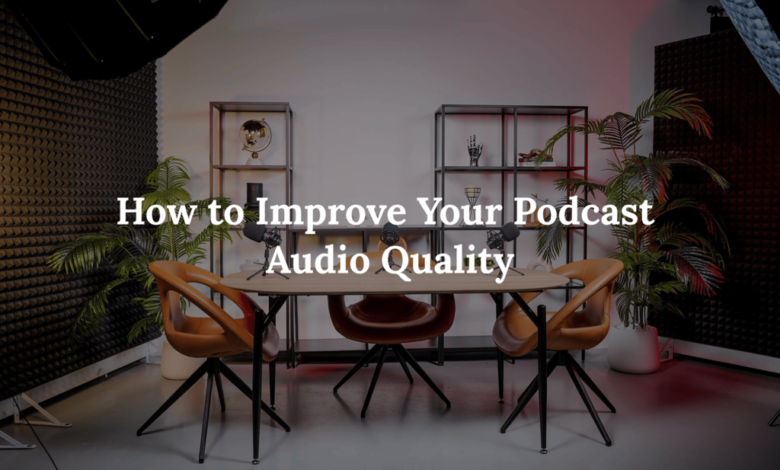How to Improve Your Podcast Audio Quality: The Complete Guide

In the fast-growing world of podcasting, sound quality defines your success. A great podcast isn’t just about storytelling or interviews. It’s about creating a listening experience that’s crisp, clear, and professional.
If your audio is filled with echo, background hum, or inconsistent volume, even the best content can lose listeners. The good news? You can improve your podcast recording dramatically without a studio or massive budget.
Let’s explore how to transform your setup, fix common issues, and master the art of podcast sound quality.
If you want to take your podcast to the next level with crystal-clear, professional sound, Emirates Podcast is your go-to partner. They’re the leading podcast service provider in Dubai, offering expert production and editing to make your voice stand out.
Why Audio Quality Matters for Your Podcast
Listeners judge your show within seconds of hitting play. Poor audio instantly signals inexperience while clean, well-balanced sound builds trust and authority.
High-quality podcast sound helps you:
- Keep listeners engaged from start to finish
- Build a professional brand image
- Reduce editing time later
- Stand out in an increasingly crowded market
Whether you’re producing from your bedroom or a rented studio, you can achieve great podcast sound quality with the right tools and habits.
1. Set Up the Perfect Recording Environment
Your environment is the foundation of every recording. Even with the best podcast microphone, poor room acoustics can ruin your sound.
Find a Quiet, Controlled Space
Pick a small, enclosed room that limits outside noise. Avoid open areas with hard surfaces, since they create echo. If possible, choose a carpeted space with curtains or furniture that naturally absorb sound.
Podcast Soundproofing Ideas
You don’t need expensive foam panels. Use what you have:
- Hang thick blankets or duvets on walls.
- Record in a walk-in closet filled with clothes.
- Use pillows or rugs to soften reflective surfaces.
These simple podcast soundproofing ideas can make a huge difference in clarity.
2. Invest in the Best Podcast Microphone You Can Afford
Your microphone shapes your entire recording quality. While software can fix small issues, it can’t fully rescue bad input.
USB vs. XLR Mics
For beginners, USB microphones like the Samson Q2U or Blue Yeti are affordable and plug directly into your computer. Professionals often prefer XLR microphones with an audio interface, such as the Rode PodMic or Shure SM7B.
Dynamic vs. Condenser Mics
Dynamic microphones are ideal for home setups because they pick up less room noise. Condenser mics capture more detail but also more background sound best used in a treated studio environment.
Choosing the best podcast microphone for your voice and space is a long-term investment in your sound.
3. Master Your Microphone Technique
Even great equipment won’t help if your technique is off. To improve podcast recording results:
- Keep your mouth about 6–8 inches from the mic.
- Use a pop filter to minimize plosive sounds.
- Speak slightly off-axis to reduce breath noise.
- Stay consistent with volume and tone.
Small adjustments like these make a world of difference to your podcast sound quality.
4. Record With Headphones and Monitor in Real Time
Monitoring your voice as you record helps catch problems before they ruin an entire episode. Use closed-back headphones to hear exactly what your audience will hear from background hum to echo.
This practice helps you notice mic placement issues, noise interference, and levels that are too high or low.
5. Record in the Right Format and Settings
Always record in WAV or AIFF format for the highest fidelity. Avoid MP3 until you’re exporting your final version.
Set your sample rate to 44.1 kHz and bit depth to 24-bit for clean, flexible editing. These professional settings maintain crystal-clear podcast sound quality throughout your workflow.
6. Use Podcast Editing Software to Polish Your Audio
Once you’ve recorded your voice, it’s time to refine it. Quality editing turns average recordings into professional productions.
Top Podcast Editing Software
- Audacity (free and powerful)
- Adobe Audition (advanced features)
- Hindenburg Journalist (podcaster-friendly interface)
- Descript (text-based editing with AI tools)
Within these programs, focus on:
- Noise reduction – Remove hum, hiss, or fan noise.
- Equalization (EQ) – Adjust your voice tone for clarity.
- Compression – Balance highs and lows for consistent sound.
- Normalization – Set final volume to -16 LUFS for streaming platforms.
If you’re new to editing, try tools like Auphonic, which automatically balance levels and enhance your podcast sound quality.
7. Use Smart Audio Compression and EQ
One of the most important audio compression tips is moderation. Don’t over-compress your voice or it will sound unnatural. Apply gentle compression to even out loud and quiet moments.
For EQ, boost low-mid frequencies for warmth and cut harsh highs that cause listener fatigue. These subtle tweaks can transform your podcast sound from amateur to studio-grade.
8. Build a Consistent Home Podcast Studio Setup
A stable recording setup ensures your episodes sound uniform. Once you find the perfect mic position, room treatment, and gain level, note your settings.
Your home podcast studio setup doesn’t need to be fancy just consistent. A small table, a boom arm, pop filter, and some DIY soundproofing can create broadcast-quality audio.
Consistency helps you develop a signature sound that listeners recognize instantly.
9. How to Reduce Noise in Podcasts
Unwanted background noise is one of the biggest challenges podcasters face. To reduce noise in podcasts, focus on both prevention and post-processing.
Before Recording
- Turn off air conditioners, fans, or loud electronics.
- Record at quiet times of day.
- Use a dynamic mic that rejects ambient sound.
After Recording
- Apply a gentle noise gate in your editing software.
- Use tools like iZotope RX or Waves NS1 to remove hum and hiss.
With these methods, you’ll produce clean, professional audio every time.
10. Keep Testing and Improving Your Sound
The best podcasters treat sound like a craft. Always test your episodes on different devices headphones, car speakers, and smartphones to ensure consistency.
Seek feedback from listeners about your podcast sound quality, and make incremental improvements over time. The more you record, the better your ear becomes.
FAQs About Podcast Audio Quality
1. What’s the best podcast microphone for beginners?
Try affordable, high-quality USB mics like the Audio-Technica ATR2100x or Samson Q2U; both are great for starting your home podcast studio setup.
2. How can I improve podcast recording quality at home?
Record in a quiet, soft-furnished space, use a pop filter, and apply EQ and compression during editing.
3. How to reduce noise in podcasts effectively?
Focus on room treatment first, then use noise reduction plugins in your podcast editing software to clean up recordings.
4. Which audio compression tips work best for podcasts?
Apply light compression with a 3:1 ratio to smooth voice dynamics without losing natural tone.
5. Do I need a professional studio to achieve great podcast sound quality?
Not at all, with smart podcast soundproofing ideas and consistent mic technique, you can sound professional from home.
Conclusion: Sound Quality Defines Your Podcast’s Success
In podcasting, clarity equals credibility. By choosing the right mic, mastering your environment, and using proper podcast editing software, you can produce episodes that sound as good as any professional studio.
Don’t let poor sound hold your message back. Start refining your setup today every episode you publish with great sound brings you closer to loyal, engaged listeners.
Your audience deserves to hear your voice clearly. Give them that experience one episode at a time.




